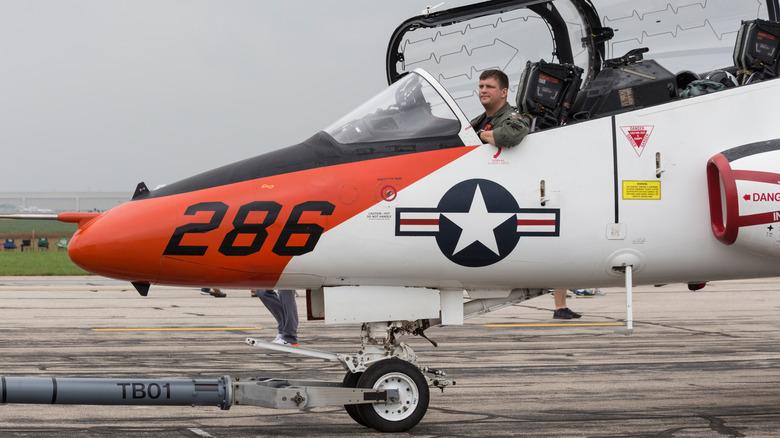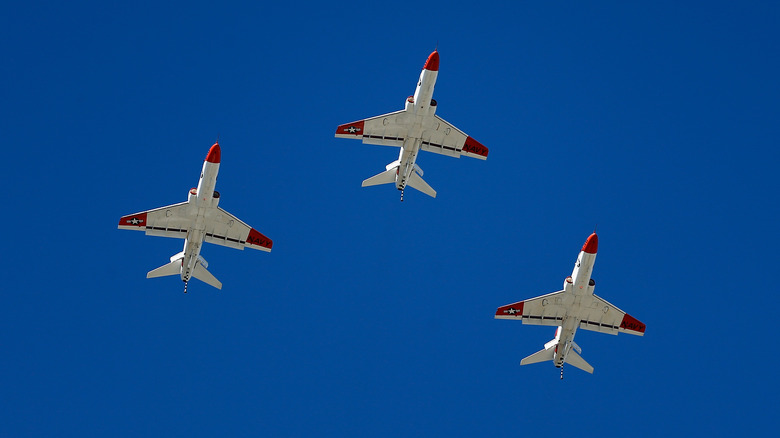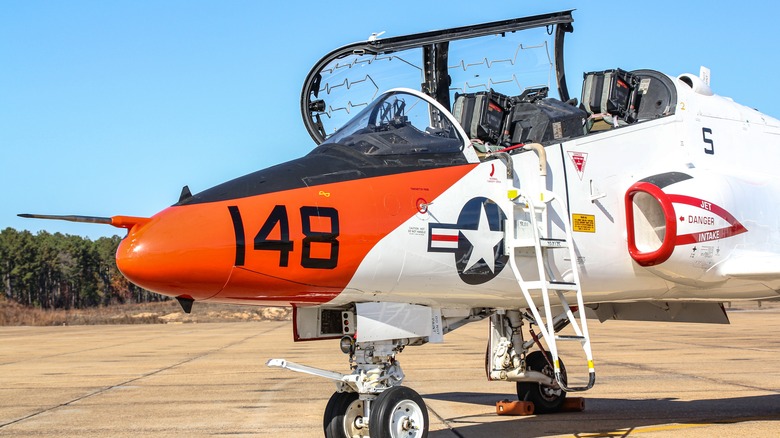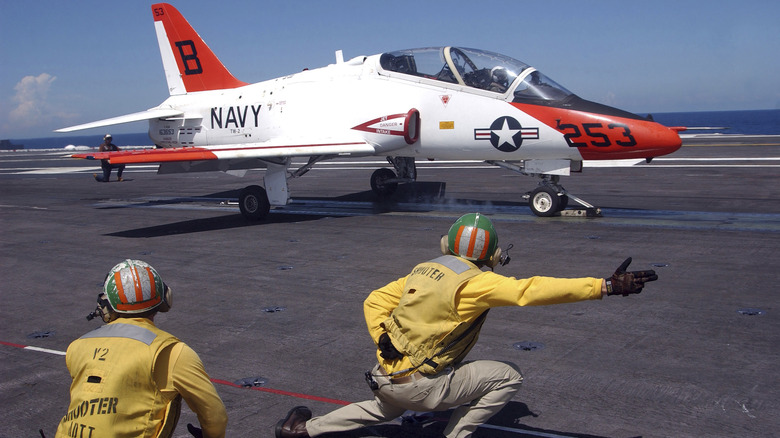Here's What Grounded The Navy T-45 Goshawk Jet
Have you ever wondered what it takes to train a Navy pilot? That's the job of the T-45 Goshawk Jet, the aircraft used to train Navy and Marine Corps fighter pilots. The tandem-seat, carrier-capable jet trainer took its first flight in April 1988 and became operational in 1991 as a modified version of the British Aerospace Hawk aircraft designed to meet Navy requirements and the rigorous demands of naval flight training, equipping future pilots with the skills they need for carrier-based operations and advanced aerial combat.
The jet serves as a critical link between basic flight training and the operation of advanced tactical aircraft, instilling them with confidence and preparing them for the situations they'll face in real life handling high-performance, carrier-based aircraft. The T-45's features include capabilities for arrested landings and catapult launches, unique to carrier-based aircraft, preparing pilots for the distinct challenges associated with naval flight operations, and ensuring they're ready for advanced naval aircraft and missions.
Despite its advanced capabilities and essential role in training the next generation of fighter pilots, issues with the jet have led to it being grounded multiple times over the years; here, we look at why.
Engine Issues Lead to Fleet Grounding
On October 14, 2022, the Navy grounded its entire fleet of T-45C Goshawk jet trainers "out of an abundance of caution and concern for the safety of our aviators," according to Rear Adm. Richard Brophy, Chief of Naval Air Training. The move affected all 193 aircraft in service. It was taken as a precautionary measure to ensure the safety of the pilots and the integrity of the training missions after the discovery of an engine blade fault. The safety pause lasted for two weeks as the Navy and its industry partner Rolls Royce investigated the problem, which came to its attention after one of the training aircraft experienced a failure in its low-pressure compressor blade prior to takeoff.
The Navy resumed flight operations for some of its T-45C Goshawk jets in late October 2022. However, in a statement, the Naval Air Systems Command explained their investigation "...has revealed that a subset of T-45C engine blades do not meet the manufacturer's engine specifications; those aircraft remain grounded," so it appears the jets affected by the specific engine blade problem remain grounded. The Navy has not disclosed the exact number of jets involved, but the partial resumption of flight operations is an indication that the issue is being addressed but hasn't been resolved for the entire fleet.
Oxygen System Concerns Halt T-45 Operations
Imagine conducting maneuvers in a fighter jet at over 42,000 feet only to experience dizziness, vertigo, or blackouts due to the failure of the onboard oxygen system that's supposed to keep you breathing. That's the scary scenario pilots faced in April of 2017, which led to the grounding of all T-45 training jets after instructors refused to fly, with one instructor telling FoxNews, "The pilots don't feel safe flying this aircraft."
Retired Vice Admiral Mike Shoemaker, who was commander of Naval Air Forces at the time, took the pilots' concerns seriously, ordering a three-day pause, which was later extended to 12 days to investigate the issue and take corrective measures, as engineers had difficulty determining what was causing the problem. While flights resumed after the 12-day pause, students weren't allowed to fly higher altitude missions or land on aircraft carriers.
According to written testimony provided to the House Armed Services Committee, incidents of adverse physiological episodes and sickness quadrupled in 2016, surging to 47 cases per 100,000 flight hours. While the Navy was never able to determine the underlying cause of the problem, in 2021, the service announced that its entire T-45 Goshawk fleet would get new smart oxygen concentrators.
Ejection Seat Malfunction Prompts Grounding
Most fighter jets have ejector seats, which give pilots a rapid and safe way to escape from an aircraft in an emergency. These seats can save a pilot's life when a jet is no longer controllable or about to crash, making them indispensable safety tools in military aviation. That's why it was so concerning when the Navy discovered a defect in the ejection seats of an undisclosed number of training aircraft, including the T-45 Goshawk, leading to the service grounding the planes in July of 2022.
The issue had been on Congress' radar after investigations linked the 2020 death of a pilot to a malfunctioning ejection seat, raising serious concerns over the safety of students and instructors. The military determined the issue was a problem affecting cartridge-actuated devices (CAD) in some fixed-wing aircraft. The CAD is the component that allows pilots to deploy the parachute when they pull the ejection handle. Since discovering the issue, the Navy said they'd replace the CADs in the affected aircraft and inspect them before their next flights.



